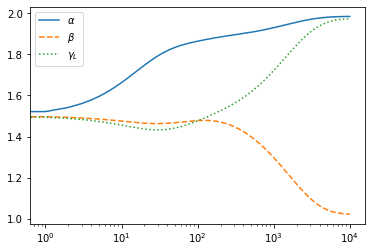Optimization of a Voigt profile¶
from exojax.spec.lpf import voigt
import jax.numpy as jnp
import matplotlib.pyplot as plt
Let’s optimize the Voigt function \(V(\nu, \beta, \gamma_L)\) using exojax! \(V(\nu, \beta, \gamma_L)\) is a convolution of a Gaussian with a STD of \(\beta\) and a Lorentian with a gamma parameter of \(\gamma_L\).
nu=jnp.linspace(-10,10,100)
plt.plot(nu, voigt(nu,1.0,2.0)) #beta=1.0, gamma_L=2.0
[<matplotlib.lines.Line2D at 0x7f5dc8143100>]
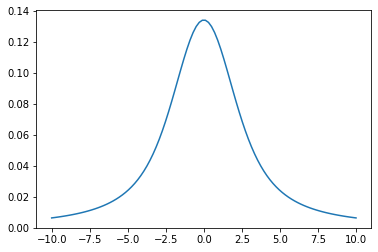
optimization of a simple absorption model¶
Next, we try to fit a simple absorption model to mock data. The absorption model is
$ f= e^{-a V(:raw-latex:`\nu`,:raw-latex:beta,:raw-latex:gamma_L)}$
def absmodel(nu,a,beta,gamma_L):
return jnp.exp(-a*voigt(nu,beta,gamma_L))
Adding a noise…
from numpy.random import normal
data=absmodel(nu,2.0,1.0,2.0)+normal(0.0,0.01,len(nu))
plt.plot(nu,data,".")
[<matplotlib.lines.Line2D at 0x7f5dc1f7ba30>]
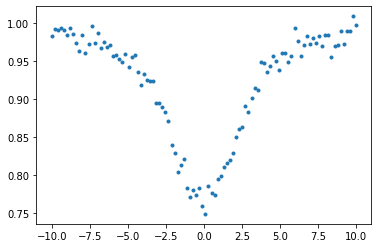
Let’s optimize the multiple parameters
from jax import grad, vmap
We define the objective function as \(obj = |d - f|^2\)
# loss or objective function
def obj(a,beta,gamma_L):
f=data-absmodel(nu,a,beta,gamma_L)
g=jnp.dot(f,f)
return g
#These are the derivative of the objective function
h_a=grad(obj,argnums=0)
h_beta=grad(obj,argnums=1)
h_gamma_L=grad(obj,argnums=2)
print(h_a(2.0,1.0,2.0),h_beta(2.0,1.0,2.0),h_gamma_L(2.0,1.0,2.0))
0.0041426932 -0.00014259202 -0.0007440491
from jax import jit
@jit
def step(t,opt_state):
a,beta,gamma_L=get_params(opt_state)
value=obj(a,beta,gamma_L)
grads_a = h_a(a,beta,gamma_L)
grads_beta = h_beta(a,beta,gamma_L)
grads_gamma_L = h_gamma_L(a,beta,gamma_L)
grads=jnp.array([grads_a,grads_beta,grads_gamma_L])
opt_state = opt_update(t, grads, opt_state)
return value, opt_state
def doopt(r0,opt_init,get_params,Nstep):
opt_state = opt_init(r0)
traj=[r0]
for t in range(Nstep):
value, opt_state = step(t, opt_state)
p=get_params(opt_state)
traj.append(p)
return traj, p
Here, we use the ADAM optimizer
#adam
#from jax.experimental import optimizers #for older versions of JAX
from jax.example_libraries import optimizers
opt_init, opt_update, get_params = optimizers.adam(1.e-1)
r0 = jnp.array([1.5,1.5,1.5])
trajadam, padam=doopt(r0,opt_init,get_params,1000)
Optimized values are given in padam
padam
DeviceArray([1.9842807, 1.0219767, 1.9737407], dtype=float32)
traj=jnp.array(trajadam)
plt.plot(traj[:,0],label="$\\alpha$")
plt.plot(traj[:,1],ls="dashed",label="$\\beta$")
plt.plot(traj[:,2],ls="dotted",label="$\\gamma_L$")
plt.xscale("log")
plt.legend()
plt.show()
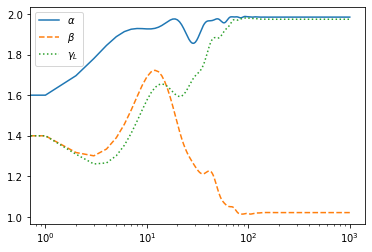
plt.plot(nu,data,".",label="data")
plt.plot(nu,absmodel(nu,padam[0],padam[1],padam[2]),label="optimized")
plt.show()
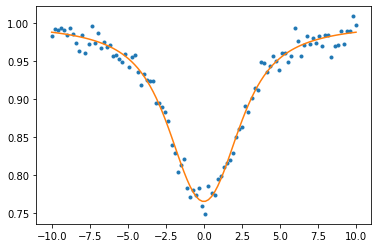
Using SGD instead…, you need to increase the number of iteration for convergence
#sgd
#from jax.experimental import optimizers #for older versions of JAX
from jax.example_libraries import optimizers
opt_init, opt_update, get_params = optimizers.sgd(1.e-1)
r0 = jnp.array([1.5,1.5,1.5])
trajsgd, psgd=doopt(r0,opt_init,get_params,10000)
traj=jnp.array(trajsgd)
plt.plot(traj[:,0],label="$\\alpha$")
plt.plot(traj[:,1],ls="dashed",label="$\\beta$")
plt.plot(traj[:,2],ls="dotted",label="$\\gamma_L$")
plt.xscale("log")
plt.legend()
plt.show()
